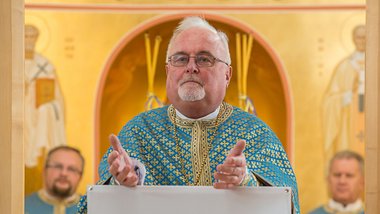A hundred historic monuments with 1200 residents: The village of Sedniv near Chernihiv
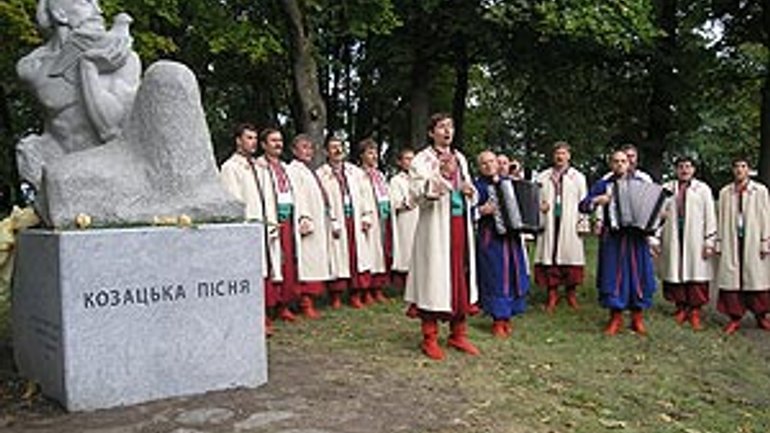
RISU’s Ukrainian-language site posted the story on 1 November 2007
Modern Sedniv is a village on the high right bank of the Snov River, 20 kilometers north of northern Ukrainian Chernihiv with a population of 1200 people. There are shops, a school, a hospital, a house of the creative work of painters, a starch-producing plant, the Closed Joint-Stock Company Chernihivelitkartoplia, and rest camps for poor children and orphans, Change and Young Chemist, there. There are also a hundred recognized historic monuments and who knows how many unrecognized, legendary, mythologized ones. Here is the report of our Chernihiv correspondent, Liubov POTAPENKO.
Once called Snovesk
Snovesk is mentioned for the first time in a chronicle in 1068. Archeological excavations give grounds to state that the settlement was founded in the 5th-6th centuries. And it is apparently named after the river Snov, on whose bank the settlement is situated.
The word “snov” is considered to be Sanskrit and means “to bathe” or “to be washed.”
At the entrance to Sedniv, on the northern side, several ancient burial mounds have been preserved: according to historians, there were about 300 of them here in the 17th century. They began to study them at the end of the 19th century. Finds, including many Scythian coins, proved that the burial mounds belong to the Scythian and early Slavic periods of history. During those explorations in Snov, silver pagan idols, worshipped by Scythians, were found. Unfortunately, all those treasures were taken not only out of the village but also out of Ukraine. It is not known what happened to them. Only written references are left…
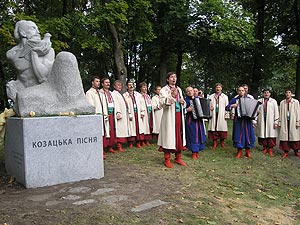 Once a Cossack capital, as well
Once a Cossack capital, as well
One can find in historical literature information that the first Cossack capital, the Sich, was founded exactly in Snovesk. This opinion is held by Prince Myshetskyi and historian O. Rigelman. Other historians think that it was the Zaporizhzhian Cossacks who played an important role in the life of the Sedniv Cossacks.
The modern name of Sedniv dates back exactly to the time of the Cossack settlement. There are many legends about that period, and Sednivers pass them on orally.
According to one of them, during an invasion of the Crimean Tatars, when the south of the Chernihiv area and the whole of the Poltava area suffered under the rule of the invaders, in the besieged Cossack town of Sedniv was concentrated not only the population of the Cossack capital but also of the surrounding villages, and they heroically defended the town for two months. They benefited both from the local hilly land and the smartness of the Cossacks, who cut all the trees on the slopes of the hills and pushed logs down the hills onto the unwelcome guests, who were climbing the hills to get to the fortress walls. The Tatars never managed to climb the Sedniv Hills: they retreated from the Sedniv Valley. In despair, the Tatars, allegedly, called those people “Sedni” (derived from “sydity” sit). Everyone liked the name and it has remained.
Local people still call the place of the victory over the Tatars “Kara-zama,” which is translated as “black mountain.” Tradition holds that the bitter path along which the Tatars drove the Ukrainian captives to slavery went precisely here, in the picturesque valley at the bottom of the hill.
There are natural terraces beneath the bluff. No excavations were ever carried out here. One can only imagine what historical valuables are being walked on. This land is also notable for the large number of springs: there are about 30 of them here.
Church of the Holy Resurrection
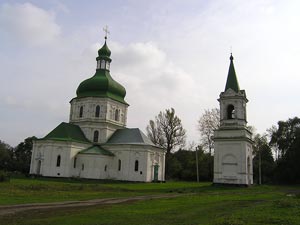 The Church of the Holy Resurrection was built in 1690, on the territory of the estate of the Lyzohub family, village elders who were of Cossack descent. According to tradition, common people went there seldom: only for great holidays or the wedding parties of landowners. Actually, all the members of that dynasty were buried in the family crypt. In the 19th century the crypt was sealed and in 1924 unknown persons opened the grave: there were 44 coffins containing mummified bodies there.
The Church of the Holy Resurrection was built in 1690, on the territory of the estate of the Lyzohub family, village elders who were of Cossack descent. According to tradition, common people went there seldom: only for great holidays or the wedding parties of landowners. Actually, all the members of that dynasty were buried in the family crypt. In the 19th century the crypt was sealed and in 1924 unknown persons opened the grave: there were 44 coffins containing mummified bodies there.
Researchers or those seeking the valuables of the Lyzohub family opened the crypt, but “forgot” to close it… And the local people, agitated by the proletarian revolution and atheistic propaganda, committed acts of vandalism and outrage on the bodies of their forefathers and the church building for many years.
The church as a historic and architectural monument only started receiving attention in the 1960s, when they began to study it. It turned out that the remnants of Yakiv Lyzohub, founder of the dynasty, were kept in the Kyivan Monastery of the Caves for a long time, and it seems other remnants from that crypt are still kept in Moscow. However, the remnants of Yakiv Lyzohub have rested in the Church of the Holy Resurrection, which he built in Sedniv, for a few years now.
Lyzohub family
According to tradition, the courage of the Cossack brothers Yakiv and Yukhym Lyzohub was noticed during the Azov expeditions of the Russian army: they were granted the title of noblemen and estates, including Sedniv. It is also proved historically that Stepan Butovych was the centurion in Sedniv and his wife, Maria, was the daughter of Chernihiv Colonel Yakiv Lyzohub. The favorite grandson of Yakiv Lyzohub, whose name was also Yakiv, also lived here: he received the Sedniv Estate when the property of his grandfather was distributed.
Of the estate of the Lyzohubs, the house itself and the so-called “Hlibov’s colonnade” have been preserved, as well as the ruins of a bridge built in 1812 over a deep moat beside an ancient defense wall popularly called Batyi’s Wall. The estate was surrounded with green gardens: one of them, with chestnut trees, is still there.
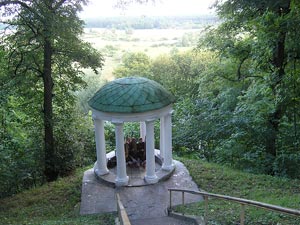 Representatives of the family, Andrii and Illia, were philanthropists and patrons of art: they brought to Sedniv wonderful plants and pieces of art from various places. A few gorgeous greenhouses were here and majestic fountains, about which legends are still told. Numerous guests were welcomed in the estate, some disgraced writers and poets hid here from persecutions and other troubles. A famous story-teller from Chernihiv, Leonid Hlibov, often visited the estate. He wrote famous poetic lines which later became a song “There is a high mountain and a grove at its foot” precisely in the structure which was later called “Hlibov’s colonnade.”
Representatives of the family, Andrii and Illia, were philanthropists and patrons of art: they brought to Sedniv wonderful plants and pieces of art from various places. A few gorgeous greenhouses were here and majestic fountains, about which legends are still told. Numerous guests were welcomed in the estate, some disgraced writers and poets hid here from persecutions and other troubles. A famous story-teller from Chernihiv, Leonid Hlibov, often visited the estate. He wrote famous poetic lines which later became a song “There is a high mountain and a grove at its foot” precisely in the structure which was later called “Hlibov’s colonnade.”
Famed Ukrainian bard and painter Taras Shevchenko also visited the Lyzohub brothers two times. In 1846, he wrote here his poem “Osyka,” painted Illia and Andrii Lyzohub’s portraits, the picture “Chumaky among the graves,” and drew many sketches. It is also known that when he came here to gather materials for the second collection of his work “Kobzar” in 1847, on his way back, at the ferry landing, he was arrested and the manuscripts were lost forever. The Lyzohub brothers maintained links with Shevchenko even after his arrest: they wrote letters and provided material support for him.
One can still see in Sedniv the favorite linden tree of Taras Shevchenko, which is 200 years old. They say at the time when the great poet rested in its shade it could shelter about 40 people.
For many years, there has been a school in the landowners’ house. In front of it, there is a monument to Taras Shevchenko, made in the 1950s by Sedniv sculptor Bystrevskyi.
There is another monument to Shevchenko beside the tree. Its story is moving: it was erected in 1904 by the Lyzohub family, and suffered a loss during the last war. A German tank pushed it off the pedestal and the bust was broken, but Sednivers kept the pedestal and renewed the bust after the war.
One cannot easily recall another town or village in Ukraine where the great poet would be so highly respected as to keep actually next to each other two monuments and a tree.
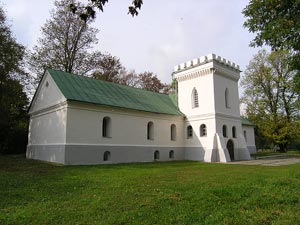 Kamianytsia
Kamianytsia
This building is a unique historic and architectural monument. It was built at the end of the 17th century simultaneously with the neighboring Church of the Holy Resurrection by Yakiv Lyzohub. The Lyzohub’s kamianytsia is a brick two-storey building (the lower floor is underground) intended for storing documents (it served as an archive) and military supplies: weapons, gun-powder, food, money.
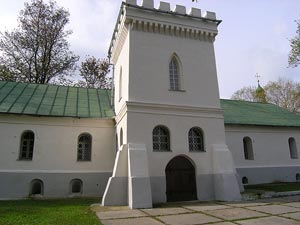 It never was a residence. That is why this mysterious object for many decades attracted treasure seekers, who damaged the thick walls of the building looking for secret niches containing hidden valuables.
It never was a residence. That is why this mysterious object for many decades attracted treasure seekers, who damaged the thick walls of the building looking for secret niches containing hidden valuables.
Taras Shevchenko liked to sit on the porch of the building and draw the landscape. His drawing of the structure has also been preserved. Sednivers say that he drew a Cossack on the entrance door, which remained there for a long time. But unfortunately, the stormy times of Soviet strife left no wooden or metal objects in the building.
There is also a legend of an underground tunnel to the Lyzohub family crypt, located under the Church of the Holy Resurrection.
Cossack church where Soviet thriller was filmed
It is one of Ukraine’s oldest wooden churches made entirely without nails. St. George’s Church, as it looks now, was built in 1745, but it existed even before the Mongol invasion. (See link BELOW for a May story on St. George’s Church.)
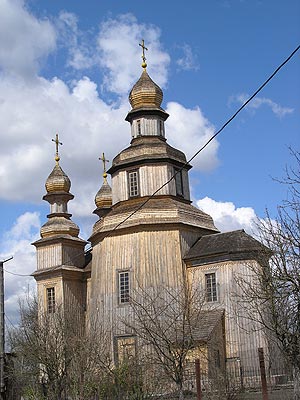 It is known also for being the place where the first Soviet horror film, “Vii,” was filmed, based on a tale by Nikolai Gogol. This summer, for the first time after the closing of the church by the Soviet regime and the “filmed” prayer of Khoma Brut, the main character of the film “Vii,” a real Divine Liturgy was celebrated in the church by priests of the Ukrainian Orthodox Church-Kyivan Patriarchate at the request of the local Cossack community.
It is known also for being the place where the first Soviet horror film, “Vii,” was filmed, based on a tale by Nikolai Gogol. This summer, for the first time after the closing of the church by the Soviet regime and the “filmed” prayer of Khoma Brut, the main character of the film “Vii,” a real Divine Liturgy was celebrated in the church by priests of the Ukrainian Orthodox Church-Kyivan Patriarchate at the request of the local Cossack community.
The film “Hryhorii Skovoroda” and several Soviet films about the war were shot in Sedniv. Also there is the House of Creative Work of the National Union of Painters of Ukraine, which has been active for more than 40 years and where noted painter Tetiana Yablonska, not to mention local painters and guests from all over the former USSR and Europe, painted many pictures.
Hryts Zolotiusinkyi, local “saint”
There is the well-preserved grave of a local, non-canonized saint, Hryts Zolotiusinkyi, in the cemetery of the Church of the Holy Resurrection. The inscription on the grave stone says that he died in 1855. They say that a wandering fool for Christ, Hrytsko Miroshnykiv, from the town of Horodnia, which is located north of Sedniv, came here and stayed here until his death.
Many local legends are associated with him. He was given his nickname (“Zolotiusinkyi” means “golden”) for being polite with people and animals and greeting everyone with the words “You, my golden one.” However, not all people were honored with such words: Hryts did not shake hands with some. With others, he shook only a finger and with some he shook hands for a long time… Apparently, there were some reasons for this.
In addition to his strangeness, he had the gift of prophecy and prediction. They say he prophesied to Taras Shevchenko that the latter would be a soldier. He also predicted the telephone: he said that people would soon speak over wires, but not many people believed him then. They say it was Hryts who rescued Sedniv from an epidemic of the plague: he distributed to people aspen pegs and the disease passed the houses where they kept them. But the blessed one did not distribute pegs to drunkards, as he disliked them very much. They say the number of drunkards reduced considerably at that time in Sedniv.
Hryts told people their fortunes. Therefore, they liked him but at the same time feared him. They gave money to the poor man, and he distributed them to people who, in his opinion, needed it more. He often walked in prayer to Kyiv. In warm weather, he slept beside the church, in cold weather, wherever they gave him shelter. Sednivers remember Hryts Zolotiusinkyi, look after his grave, and believe that he was a saint.
Illia Shrah, Ukrainian patriot
Once Illia Lyzohub invited a German man, Lyps Ludvig, doctor of medicine of the University of Shrah, to come to Sedniv at least “for three years.” He agreed and soon after married a local girl of the noble family of Kolodkevych-Pysarenko. In 1847, a son was born to them. He was named Illia after his godfather. “…The Lyzohubs had Ukrainian sympathies, especially Andrii and Vasyl… In general, at that time, in circles of village elders and priests, the Ukrainian element was still brightly reflected. My godmother, Dokia Petrivna Lyzohub,…always spoke only Ukrainian and knew no other language. My uncle’s mother in law, Krupytska, the wife of a priest, also spoke only Ukrainian; whereas Krupytska’s son, an officer, spoke Muscovite [Russian], stressing his ‘education.’ My uncle almost always used Ukrainian, and when he thought it necessary to speak Muscovite, he distorted it terribly,” recalled Illia Shrah, one of the best lawyers of Ukraine of that time, a defender of the interests of the Chernihiv peasants, a public and political figure.
He was elected deputy mayor of Chernihiv and was one of the founders of the Chernihiv Archives Commission. But his gift and character were used the most in the area of the Ukrainian movement: he organized a Prosvita (“Enlightenment”) Society in Chernihiv, supported teaching at schools in the Ukrainian language and the translation of holy scripture into Ukrainian.
In 1906, he was elected deputy of the First State Duma, where he headed the Ukrainian faction. In 1917, he joined the Central Rada, worked on a draft “Statutes of the autonomy of Ukraine,”and was invited to be the prime minister in the government of P. Skoropadskyi. But he refused due to his poor health. Then the position was held by another Sedniver, Fedir Lyzohub.
Illia Shrah died in 1919 and is buried near the Church of the Holy Resurrection in Chernihiv. Recently, a memorial plaque was established in Chernihiv in memory of the outstanding local resident.
P.S. By the way, six years ago, the Kamianytsia underwent capital repair at the expense of Chernihivoblenergo [Chernivhiv Regional Energy] company, and in the summer of this year, construction of a new school was started. It is planned to renovate the old house of the Lyzohubs, which is still used as the school, to be a museum of local lore.







